"That looks like a new pump!" my wife observed as I wrestled it from the lazarette and stood up with it. "Don't judge a book by it's cover", I replied and hopped off the boat with it. The Gusher 10 had failed to prime once again, and this was to be the last time. Resisting the urge to pitch it into the dumpster, I instead tossed it in the back of my truck, knowing I needed to document this project. I cannot be the first person who has thought of replacing this pump with a better version, possibly plastic.
After all, thousands were installed as original equipment from boat manufacturers. I was able to find little on the internet, so documenting my project seemed like a good idea. This particular pump had been installed 3 years earlier, and already been rebuilt twice in that time. Many Ericson's have deep bilges and you need a pump capable of overcoming some 7 feet of head.
Diaphram pumps are a good solution, and at first blush, the Gusher 10 seems like a good value compared to offerings by other manufacturers. To me, this pump reminds me of the 2 coats of varnish put on brand new boats-looks great in the showroom, but let's see how it holds up in a year or so.
Before going on, a few thoughts on manual bilge pumps. Electric pumps usually work great, especially at the dock but don't kid yourself. I have been around boats all my life and have observed that electric anything aboard can fail, usually at the wrong time for any variety of reasons. If the shit hits the fan, and you are really in trouble, that manual pump (or the scared man with a bucket) is your go to, and had better be reliable in my view. Which brings me to this- yeah it looks nice and robust, but let's dig a little deeper.
Let's see, stainless screws tapped into a cast aluminum body, and regularly doused with saltwater. What could possibly go wrong?
Notice a screw is missing as it had completely stripped out on the second rebuild. I could say more about this, but I think the picture says it all. The smallest
bit of crud can prevent the valve from seating and the pump will not prime. This thing had to go, I still can't believe how long I had put up with it. If you have one of these aboard your boat, and you sail in saltwater, take a good look at the picture above.
Fortunately, the Titan, also manufactured by Whale looked to be similar in specs but built out of plastic, had just arrived.
Similar in size, but with quite a few differences. One of which was the use of c clips instead of nylock nuts on the pivot shafts. I'm guessing
cost savings? Not a problem sitting on a workbench, but not so easy to disassemble once installed.
Delving deeper, similar style valves in an all plastic body.
Continued in next blog post.





